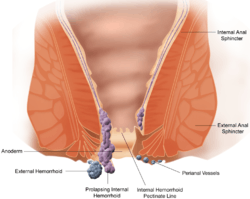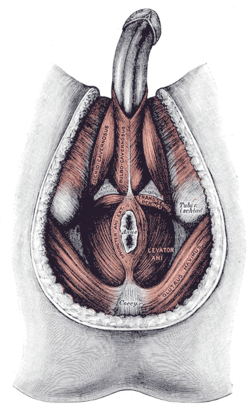Human anus
| Anus | |
|---|---|
 | |
The human anus (from Latin anus meaning "ring", "circle")[1][2] is the external opening of the rectum. Two sphincters control the exit of feces from the body during an act of defecation, which is the primary function of the anus. These are the internal anal sphincter and the external anal sphincter, which are circular muscles that normally maintain constriction of the orifice and which relaxes as required by normal physiological functioning. The inner sphincter is involuntary and the outer is voluntary. It is located behind the perineum which is located behind the vagina in females and behind the scrotum in males.
With anal sex, the anus can play a role in sexuality. Attitudes towards anal sex vary and it is illegal in some countries.[3] The anus is often considered a taboo part of the body,[3] and it is known by a large number of usually vulgar slang terms. The anus is also the site of potential infections and other conditions, including cancer. The traditional polite synonym for anus was fundament, though this euphemism is rarely heard now that medical terms are widely acceptable.
Structure

The anus is the final component of the gastrointestinal tract, and directly continues from the rectum. The anus passes through the pelvic floor. The anus is surrounded by muscles. The top and bottom of the anus are surrounded by the internal and external anal sphincters, two muscular rings which control defeaecation.[4]:397
The anus is surrounded in its length by folds called anal valves, which converge at a line known as the pectinate line. This represents the point of transition between the hindgut and the ectoderm in the embryo. Below this point, the mucosa of the internal anus becomes skin.[4] :397 The pectinate line is also the division between the internal and external anus.
Histology
The pseudostratified columnar epithelium of the gastrointestinal tract transitions to stratified squamous epithelium at the pectinate line. The stratified squamous epithelium gradually accumulates sebaceous and apocrine glands.[5] :285
Development
During puberty, as testosterone triggers androgenic hair growth on the body, pubic hair begins to appear around the anus. Although initially sparse, it fills out by the end of puberty, if not earlier. However, in some genetic populations androgenic hair is less common.
Function
Defecation
Intra-rectal pressure builds as the rectum fills with feces, pushing the feces against the walls of the anal canal. Contractions of abdominal and pelvic floor muscles can create intra-abdominal pressure which further increases intra-rectal pressure. The internal anal sphincter (an involuntary muscle) responds to the pressure by relaxing, thus allowing the feces to enter the canal. The rectum shortens as feces are pushed into the anal canal and peristaltic waves push the feces out of the rectum. Relaxation of the internal and external anal sphincters allows the feces to exit from the anus, finally, as the levator ani muscles pull the anus up over the exiting feces.
Clinical significance
- Birth defects, including imperforation, stenosis, Tailgut cyst
- Fistula and anal fissure
- Hemorrhoids
- Anal abscesses
- Sexually transmitted infections
- Anal warts, also called "anal condyloma"
- Anal cancer, also called "anal carcinoma", and Anal intraepithelial neoplasia
- Itchiness, called Pruritus ani
- Trauma; damaged anal sphincter (patulous anus in more severe cases)—caused by careless or sometimes necessarily sacrificial surgery in the perineal region or by rough/abrupt penetration in anal sex—can lead to flatus and/or fecal incontinence, chronic constipation and, ultimately, megacolon.
-

Example of a Grade IV hemorrhoid, one that protrudes out of the anus.
-
SOA-Condylomata-acuminata-around-anus.jpg
Example of Anal warts.
Psychology
In psychology, the Freudian term anal fixation is used.
Society and culture
Sexuality
The anus has a relatively high concentration of nerve endings and can be an erogenous zone, which can make anal intercourse pleasurable. The pudendal nerve that branches to supply the external anal sphincter also branches to the dorsal nerve of clitoris and the dorsal nerve of penis.
Sigmund Freud's theory of psychosexual development, for example, described an anal stage, hypothesizing that toddlers derive pleasure from retaining and expelling feces. This is the source of the term "anal-retentive" and the derived informal term "anal".
In addition to nerve endings, pleasure from anal intercourse occurs due to the shared wall between the anus and the prostate for males and vagina/G-Spot for females. This allows for indirect stimulation of the G-Spot or clitoral legs in women, and prostate in men.[6][7][8][9] For a male insertive partner, the tightness of the anus can be a source of pleasure via the tactile pressure on the penis.[8][10] Pleasure from the anus can also be achieved through anal masturbation, fingering,[3] fisting, facesitting, anilingus, and other penetrative and non-penetrative acts. Anal stretching can stimulate the nerves around the anus and can be considered pleasurable. Care must be taken to maintain elasticity. Lubricant is widely regarded as a necessity while performing anal sex.[11][12][13][14]
Anal intercourse is sometimes referred to as sodomy or buggery, and is considered taboo in a number of legal systems. It has been, and in some jurisdictions continues to be, a crime carrying severe punishment.[3]
Hygiene
To prevent diseases of the anus and to promote general hygiene, humans often clean the exterior of the anus after emptying the bowels. A rinse with water from a bidet or a wipe with toilet paper are often used for this purpose, though anal cleansing practices vary greatly between cultures.
Cosmetics
Shaving, trimming, depilatory (hair removal), or Brazilian waxing can clear the perineum of hair.
Anal bleaching is a process in which the anus and perineum, which may darken after puberty depending on individual genetics, is lightened for a more youthful appearance.
True anal piercing is rare because it may interfere with the function of the anus. However, surface piercings of the perineum are easier to care for and much more common.
Additional images
-

Muscles of the male perineum
-

Muscles of the female perineum
-

The posterior aspect of the rectum and anus exposed by removing the lower part of the sacrum and the coccyx
See also
| Look up anus in Wiktionary, the free dictionary. |
| Wikimedia Commons has media related to Human anus. |
- Anal bleaching
- Anal stage (Freudian psychosexual stage)
- Anococcygeal nerve
- Buttocks
- Cloaca
- Coccydynia
- Coccyx
- Digestive system
- Flatulence
- Hemorrhoid
References
- ↑ Martim de Albuquerque (1873). Notes and Queries. Original from the University of Michigan: Oxford University Press. p. 119.
- ↑ Edward O'Reilly; John O'Donovan (1864). An Irish-English Dictionary. Original from Oxford University: J. Duffy. p. 7.
- 1 2 3 4 "Anal Sex, defined". Discovery.com. Archived from the original on June 13, 2002. Retrieved July 23, 2013.
- 1 2 Drake, Richard L.; Vogl, Wayne; Tibbitts, Adam W.M. Mitchell (2005). Gray's anatomy for students. illustrations by Richard; Richardson, Paul. Philadelphia: Elsevier/Churchill Livingstone. ISBN 978-0-8089-2306-0.
- ↑ Deakin, Barbara Young ... [et al.] ; (2006). Wheater's functional histology : a text and colour atlas. drawings by Philip J. (5th ed.). [Edinburgh?]: Churchill Livingstone/Elsevier. ISBN 978-0-443-06850-8.
- ↑ "The male hot spot — Massaging the prostate". Go Ask Alice!. September 27, 2002 [Revised/updatedMarch 28, 2008]. Retrieved April 21, 2010.
- ↑ Komisaruk, Barry R.; Whipple, Beverly; Nasserzadeh, Sara; Beyer-Flores, Carlos (2009). The Orgasm Answer Guide. JHU Press. pp. 108–109. ISBN 978-0-8018-9396-4. Retrieved January 20, 2014.
- 1 2 See page 3 for women preferring anal to vaginal, and page 15 for reaching orgasm through indirect stimulation of the G-Spot. Taormino, Tristan (1997). The Ultimate Guide to Anal Sex for Women. Cleis Press. ISBN 978-1-57344-221-3. Retrieved November 6, 2011.
- ↑ Natasha Janina, Valdez (2011). Vitamin O: Why Orgasms Are Vital to a Woman's Health and Happiness, and How to Have Them Every Time!. Skyhorse Publishing Inc. ISBN 978-1-61608-311-3. Retrieved November 6, 2011.
- ↑ Joann S. DeLora; Carol A. B. Warren; Carol Rinkleib Ellison (1981) [Digitized May 29, 2008]. Understanding sexual interaction. Houghton Mifflin (Original from the University of Virginia). p. 123. ISBN 978-0-395-29724-7. Retrieved November 6, 2011.
- ↑ Dean, John; Delvin, David. "Anal sex". Netdoctor.co.uk. Retrieved April 29, 2010.
- ↑ Carroll, Janell L. (2009). Sexuality Now: Embracing Diversity. Cengage Learning. p. 271. ISBN 978-0-495-60274-3. Retrieved 2010-12-19.
- ↑ Heidelbaugh, Joel J. (2007). Clinical men's health: evidence in practice. Elsevier Health Sciences. p. 273. ISBN 978-1-4160-3000-3. Retrieved 2011-10-14.
- ↑ Carballo-Diéguez, Alex; Stein, Z.; Sáez, H.; Dolezal, C.; Nieves-Rosa, L.; Díaz, F. (2000). "Frequent use of lubricants for anal sex among men who have sex with men" (PDF). American Journal of Public Health. 90 (7): 1117–1121. doi:10.2105/AJPH.90.7.1117. PMC 1446289
 . PMID 10897191.
. PMID 10897191.